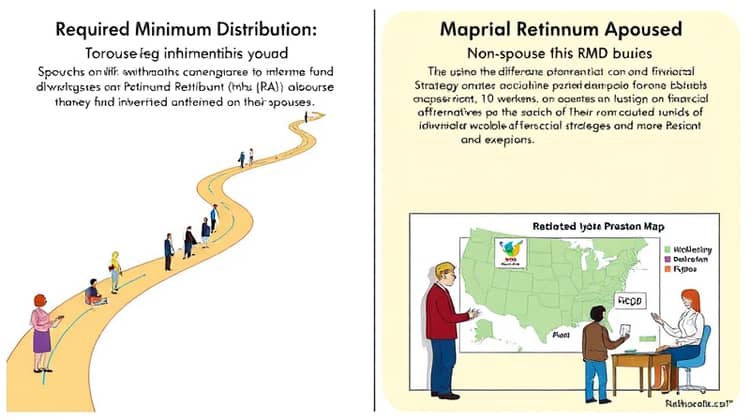Navigating the terrain of retirement planning can be monumental, particularly when it comes to understanding specific regulations that affect your savings and income. One of the critical aspects of this journey is comprehending Required Minimum Distributions (RMDs). RMDs ensure that retirees eventually draw down their tax-advantaged retirement accounts, as these accounts are not just meant to accumulate wealth without eventual withdrawal.
Understanding RMDs is vital for effective retirement planning, as failing to take them can lead to substantial penalties. This comprehensive guide aims to demystify RMDs. We will cover what RMDs are, when they commence, which accounts are affected, how they are calculated, and more. By gaining clarity on these aspects, you can better manage your retirement withdrawals to align with your financial goals.
In this article, you will find detailed insights on RMDs, including their associated taxes, consequences of neglecting them, and any unique scenarios that might apply to your situation. Whether you are nearing retirement or already retired, being informed about RMDs is essential to avoid any unpleasant surprises in the future.
What Are Required Minimum Distributions (RMDs)?

Required Minimum Distributions, or RMDs, are mandatory withdrawals that individuals holding certain retirement accounts must begin taking when they reach a specified age. The Internal Revenue Service (IRS) mandates these distributions to ensure that the money saved in retirement accounts eventually gets taxed rather than growing indefinitely without tax implications.
RMDs apply to various retirement accounts, including traditional IRAs, 401(k)s, and other tax-deferred accounts, where contributions were made without immediate tax deduction. The essence of RMDs is to prevent individuals from hoarding tax-sheltered savings indefinitely and to facilitate the IRS's collection of taxes on those funds.
The precise amount that needs to be withdrawn depends on several factors, including the account owner's age, life expectancy, and the account balance as of December 31 of the previous year. Therefore, RMDs can significantly impact financial planning during retirement, as they alter the cash flow landscape of a retiree's income.
When Do RMDs Begin?

RMDs generally begin on April 1 of the year following the year you turn 72, which is the age set by the IRS to compel withdrawals. If you reach the age of 72 in 2023, for example, you will be required to take your first RMD by April 1, 2024. However, this first withdrawal can create a tax burden, as it will be included in your taxable income for that year.
After the initial RMD, subsequent distributions need to be taken by December 31 of each year. This ongoing requirement underscores the importance of planning since failing to withdraw the correct amount by the deadline may result in significant penalties. It's crucial to mark your calendar to avoid missing these dates and incurring additional financial responsibilities.
For account holders who continue working past age 72 and are still contributing to a retirement plan, RMD rules may vary. If you're still employed and have a 401(k) through your employer, your RMD may be delayed until you leave your job. Thus, understanding your specific situation is equally important to ensure compliance with the IRS rules.
Which Accounts Are Subject to RMDs?

Not all retirement accounts require RMDs. Generally, RMDs are mandated for most retirement accounts where tax-deductible contributions were made. Traditional IRAs, 401(k)s, and similar plans are subject to these regulations to ensure that funds are withdrawn and taxed in due course.
However, Roth IRAs differ from traditional IRAs in this realm. Accounts that are classified as Roth IRAs do not require RMDs during the owner’s lifetime. This distinction provides a strategic advantage, allowing for tax-free growth and withdrawal flexibility for those who wish to defer taking income until later in life.
Additionally, it's important to note that any accounts inherited typically come with their own RMD rules. The withdrawal requirements can vary based on whether the beneficiary is a spouse, child, or another relative, so understanding these distinctions is essential for effective estate planning.
- Traditional IRAs
- 401(k) plans
- 403(b) plans
- 457(b) plans
- Inherited IRAs
As RMD rules can vary based on account types and beneficiaries, maintaining awareness of these distinctions is crucial for financial and estate planning.
How Is the RMD Calculated?

RMD calculations are primarily based on the account balance and the IRS's life expectancy tables. At the beginning of each year, the total account balance from the prior year is used to determine your RMD for that year. The IRS provides tables that outline the distribution period based on life expectancy, which varies with age. For example, a 72-year-old has a distribution period of about 25.6 years, according to the IRS’s Uniform Lifetime Table.
The formula for calculating the RMD is straightforward: divide the account balance by the distribution period. This provides a clear number indicating how much needs to be withdrawn for that year. It is essential to account for all applicable retirement accounts to ensure that you take the correct RMD amount from each. If you have multiple accounts, you can aggregate the totals and take the sum total from one or multiple accounts to fulfill the requirement.
It’s important to also consider any changes in account balances, especially in volatile markets. A decrease in your account balance will lead to a lower RMD in succeeding years, while an increase will require a larger distribution. This dynamic nature of RMD calculations underscores the importance of staying vigilant about your investments as you approach retirement age.
Lastly, keep in mind that these calculations must be done annually, and seeking professional advice can be beneficial to ensure compliance. Moreover, monitoring your RMDs can help you manage your overall tax obligations effectively.
How to Take an RMD

Taking RMDs can be a straightforward process if you stay organized and informed. Begin by calculating your RMD based on the balance of your accounts and the IRS tables. Once you have calculated your RMD, you can choose the method of withdrawal that suits you best, whether through direct transfer, check, or another convenient option offered by your financial institution.
It’s crucial to take the full RMD amount before the deadline to avoid any penalties. Consider setting reminders in your financial calendar for when your RMDs are due. Adjusting your withdrawal plan annually is also advisable to stay compliant with any changes in IRS regulations or your financial situation.
- Calculate your RMD based on previous year-end balances.
- Select your method of withdrawal (direct transfer, check, etc.).
- Withdraw the required amount before the RMD deadline.
- Adjust your withdrawal strategy annually as needed.
By following these steps methodically, you can efficiently navigate the RMD process while minimizing pitfalls associated with tax penalties.
RMDs and Taxes

RMDs are generally considered taxable income, and it's essential to understand how they will affect your tax situation for the year. When you take your RMD, the amount is added to your taxable income for that year, impacting your overall tax liability. Keeping track of your withdrawals can help you prepare for the tax implications at year-end.
If you are still working and contributing to a retirement plan, remember that your RMDs could affect the tax bracket you fall into, especially if your total income increases significantly due to RMD withdrawals. This could lead to a higher tax bill, and being proactive with tax planning is often beneficial for managing your financial landscape.
- Include your RMD in your annual taxable income.
- Consult a tax professional for effective planning.
- Consider tax implications of increased income due to RMDs.
Planning for taxes related to RMDs can ultimately support more strategic decision-making in your retirement withdrawals.
Failure to Take RMDs

Failing to take the correct RMD can lead to severe penalties imposed by the IRS. If you neglect to withdraw the required minimum, you will face a hefty penalty amounting to 50% of the amount that should have been withdrawn but was not.
This penalty is punitive and can significantly impact your retirement savings, stressing the importance of being mindful of your RMD obligations each year. Developing a robust withdrawal strategy and staying informed will go a long way in ensuring you meet all requirements and avoid unnecessary penalties.
- Monitor your RMD deadlines annually.
- Work with financial advisors to ensure compliance.
- Utilize automated withdrawal tools offered by financial institutions.
Taking routine steps can help eliminate the risk of forgetting RMDs, thus safeguarding your finances.
Special Situations

There are various special situations surrounding RMDs that can affect how and when you need to withdraw funds. For instance, if you inherit an IRA, the RMD calculation will differ based on whether you are a spouse or a non-spouse beneficiary, with some inheritors having the option to withdraw over their lifetime, while others are constrained to a 10-year withdrawal period.
Additionally, if you are facing financial difficulties or significant medical expenses, consider consulting with a financial advisor. They may explore alternative strategies or exemptions that could apply to your specific situation. Understanding these nuances can provide flexibility when planning your withdrawals.
- Inherited IRA RMD rules differ for spouses and non-spouses.
- Consulting a financial advisor for special circumstances can be beneficial.
These considerations highlight the importance of personalized financial planning tailored to individual circumstances.
Changes in RMD Rules

RMD rules have undergone numerous changes over the years, which can significantly affect your retirement strategy. Recent legislation, such as the SECURE Act, modified the age at which RMDs must begin, increasing it from 70.5 to 72. This adjustment gives retirees a little extra time to grow their savings before being forced to withdraw funds.
Furthermore, ongoing discussions in Congress regarding RMD legislation highlight the potential for further changes that could affect distribution timelines and amounts. Stay vigilant about these adjustments, as they may necessitate revisions to your financial planning strategies. Mutations in tax policies and withdrawal requirements can reshape your approach during retirement planning, so remaining proactive is crucial. Have a reliable source of information about potential regulatory changes.
Conclusion

Understanding Required Minimum Distributions is a vital part of effective retirement planning. With the potential for penalties and tax implications, being proactive in managing RMDs can save you significant financial distress in the future. As you navigate your retirement landscape, it's crucial to be informed and stay updated on the rules surrounding RMDs, particularly as legislation may change over time.














